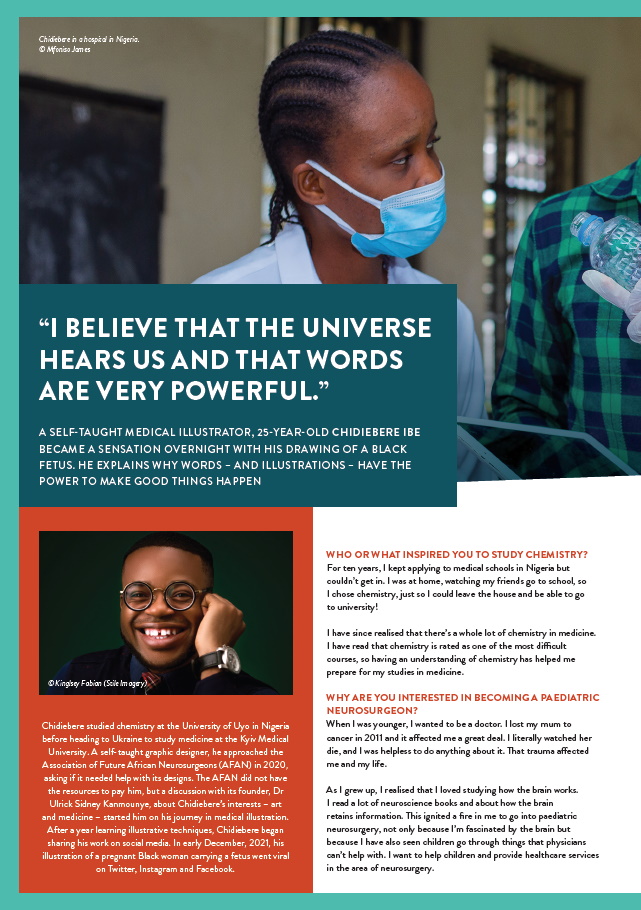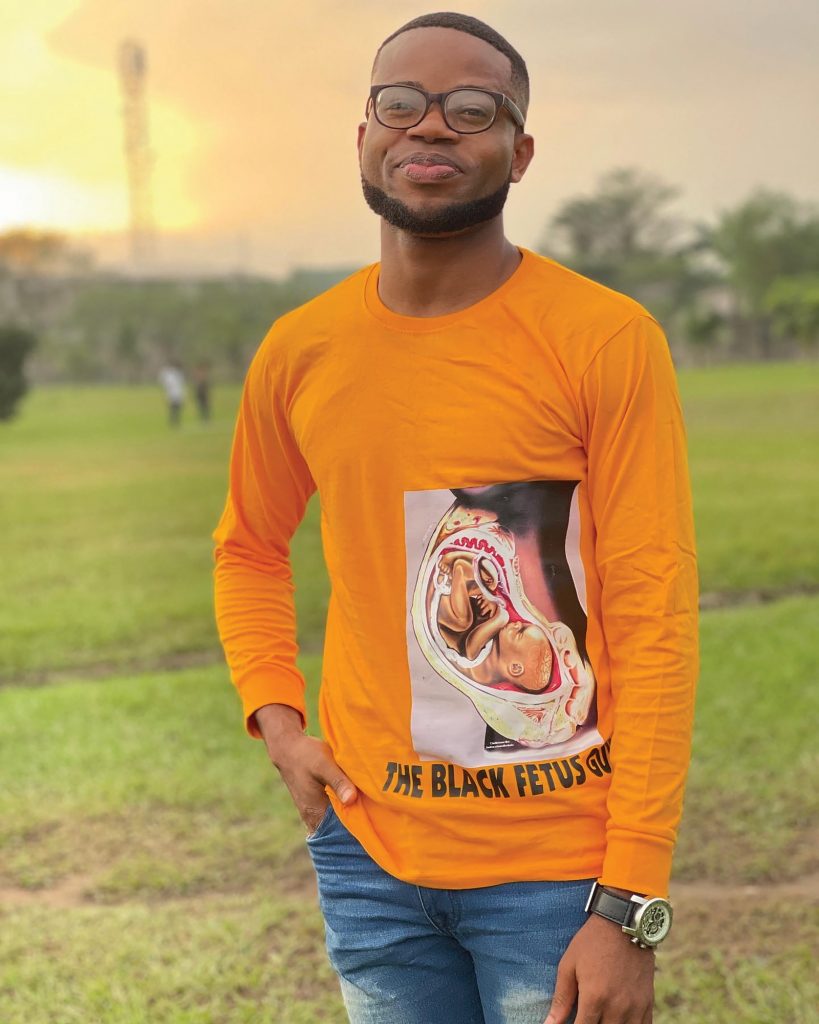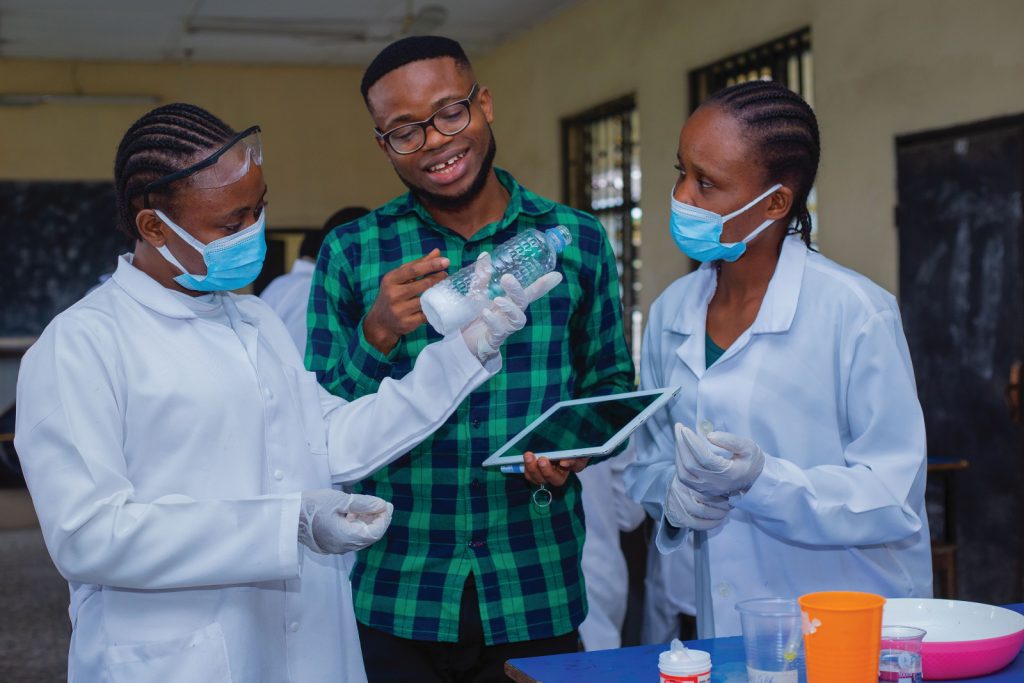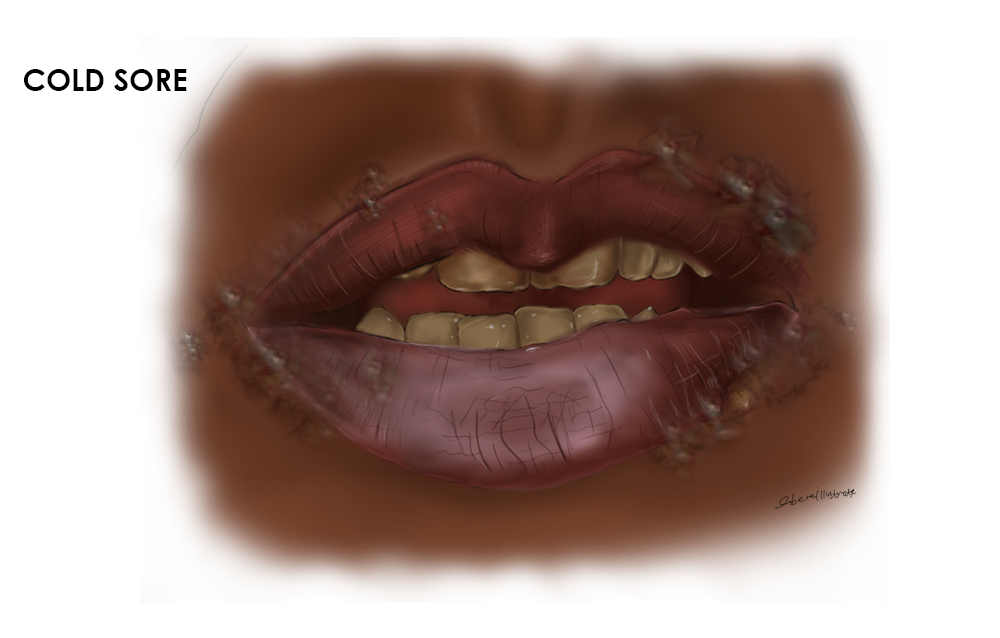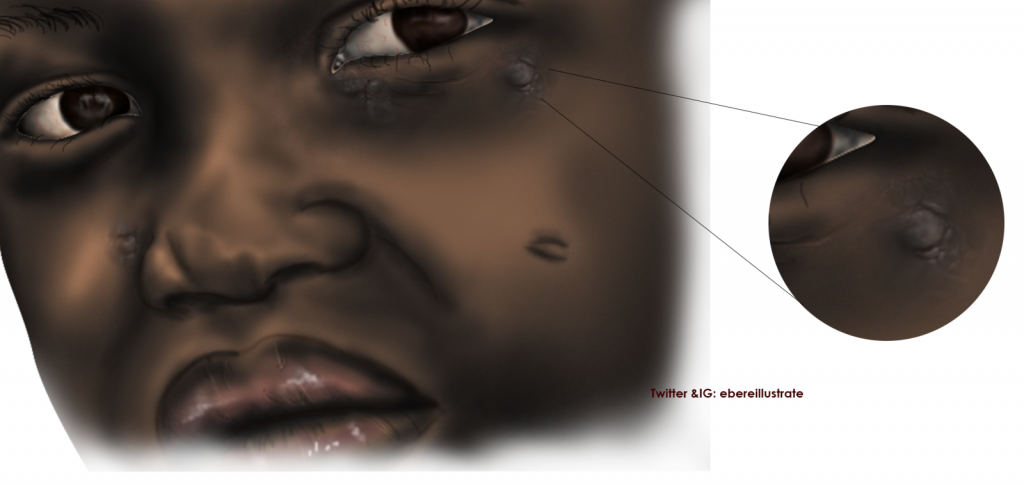“I believe that the universe hears us and that words are very powerful.”
A self-taught medical illustrator, 25-year-old Chidiebere Ibe became a sensation overnight with his drawing of a Black fetus. He explains why words – and illustrations – have the power to make good things happen
WHO OR WHAT INSPIRED YOU TO STUDY CHEMISTRY?
For ten years, I kept applying to medical schools in Nigeria but couldn’t get in. I was at home, watching my friends go to school, so I chose chemistry, just so I could leave the house and be able to go to university! I have since realised that there’s a whole lot of chemistry in medicine.
I have read that chemistry is rated as one of the most difficult courses, so having an understanding of chemistry has helped me prepare for my studies in medicine.
WHY ARE YOU INTERESTED IN BECOMING A PAEDIATRIC NEUROSURGEON?
When I was younger, I wanted to be a doctor. I lost my mum to cancer in 2011 and it affected me a great deal. I literally watched her die, and I was helpless to do anything about it. That trauma affected me and my life.
As I grew up, I realised that I loved studying how the brain works. I read a lot of neuroscience books and about how the brain retains information. This ignited a fire in me to go into paediatric neurosurgery, not only because I’m fascinated by the brain but because I have also seen children go through things that physicians can’t help with. I want to help children and provide healthcare services in the area of neurosurgery.
WHY HAVE YOU CHOSEN TO STUDY AT KYIV MEDICAL UNIVERSITY?
I had been applying to medical schools in Nigeria, the US and the UK but wasn’t accepted, so I thought I would have a better chance of applying in Ukraine. Compared to Nigeria, college education in Ukraine is good, and the school fees are inexpensive, which means I can afford to pay for my tuition fees by working part time.
Ukraine has a lot of people from different cultures. There are a lot of international students, including Nigerians.
WHAT PROMPTED YOU TO START DRAWING MEDICAL ILLUSTRATIONS IN 2020?
During lockdown, I was bored! When I saw some graphic designs created by the Association of Future African Neurosurgeons (AFAN), I didn’t think they were as good as they could be, so I reached out to them on Facebook. I received a prompt response saying that there were no resources to pay me as the association was new. Because I’m passionate about neurosurgery, I offered to do its graphic designs free of charge.
Then, my mentor, Dr Ulrick Kanmounye, saw my drawings of African children and said, “Your passions are art and medicine, so why not integrate these two together?” I had never done medical illustration before – what a thought! I did some research and found it very interesting, but I didn’t know anything about anatomy. Learning about it was a gradual process. I started teaching myself until I learned how to do the illustrations.
WHAT WAS YOUR FIRST PIECE OF MEDICAL ARTWORK?
My first illustration was of the gastrointestinal tract, which I’m not proud of. Back then, I was like, wow, this is nice, but now I can see it wasn’t good and I’ve improved over the years, thank goodness!
WHEN YOU PUT YOUR ILLUSTRATION OF A BLACK FETUS ON SOCIAL MEDIA, DID YOU EXPECT TO HAVE SUCH AN OVERWHELMING REACTION?
People ask me this a lot. Of course, nobody knows whether they will be famous someday, right? There wasn’t any particular expectation that I was going to be famous. What’s more important is that you put your hard work out there. For me, personally, I’ve been putting my work on social media since 2020 and I advocate for more drawings of Black people to be included in medical textbooks.
When that particular drawing hit the internet, I was literally crying because I didn’t expect that to happen. At the time, I was distraught because it happened the week my visa was denied. I wasn’t expecting the drawing to be so popular. When it happened, I was like, wow, I have to sit down and think about what is happening in my life right now.
I couldn’t keep up with my emails; I couldn’t keep up with the messages on social media. It was a moment in my life that really caught me off guard, but I’m grateful for the opportunity. My goal was never to be famous. I didn’t know you can be famous for making illustrations. I’m just doing what I’m doing with passion, really pouring out my heart and doing what I believe in.
WHO OR WHAT INSPIRED YOU TO STUDY CHEMISTRY?
For ten years, I kept applying to medical schools in Nigeria but couldn’t get in. I was at home, watching my friends go to school, so I chose chemistry, just so I could leave the house and be able to go to university! I have since realised that there’s a whole lot of chemistry in medicine.
I have read that chemistry is rated as one of the most difficult courses, so having an understanding of chemistry has helped me prepare for my studies in medicine.
WHY ARE YOU INTERESTED IN BECOMING A PAEDIATRIC NEUROSURGEON?
When I was younger, I wanted to be a doctor. I lost my mum to cancer in 2011 and it affected me a great deal. I literally watched her die, and I was helpless to do anything about it. That trauma affected me and my life.
As I grew up, I realised that I loved studying how the brain works. I read a lot of neuroscience books and about how the brain retains information. This ignited a fire in me to go into paediatric neurosurgery, not only because I’m fascinated by the brain but because I have also seen children go through things that physicians can’t help with. I want to help children and provide healthcare services in the area of neurosurgery.
WHY HAVE YOU CHOSEN TO STUDY AT KYIV MEDICAL UNIVERSITY?
I had been applying to medical schools in Nigeria, the US and the UK but wasn’t accepted, so I thought I would have a better chance of applying in Ukraine. Compared to Nigeria, college education in Ukraine is good, and the school fees are inexpensive, which means I can afford to pay for my tuition fees by working part time.
Ukraine has a lot of people from different cultures. There are a lot of international students, including Nigerians.
WHAT PROMPTED YOU TO START DRAWING MEDICAL ILLUSTRATIONS IN 2020?
During lockdown, I was bored! When I saw some graphic designs created by the Association of Future African Neurosurgeons (AFAN), I didn’t think they were as good as they could be, so I reached out to them on Facebook. I received a prompt response saying that there were no resources to pay me as the association was new. Because I’m passionate about neurosurgery, I offered to do its graphic designs free of charge.
Then, my mentor, Dr Ulrick Kanmounye, saw my drawings of African children and said, “Your passions are art and medicine, so why not integrate these two together?” I had never done medical illustration before – what a thought! I did some research and found it very interesting, but I didn’t know anything about anatomy. Learning about it was a gradual process. I started teaching myself until I learned how to do the illustrations.
WHAT WAS YOUR FIRST PIECE OF MEDICAL ARTWORK?
My first illustration was of the gastrointestinal tract, which I’m not proud of. Back then, I was like, wow, this is nice, but now I can see it wasn’t good and I’ve improved over the years, thank goodness!
WHEN YOU PUT YOUR ILLUSTRATION OF A BLACK FETUS ON SOCIAL MEDIA, DID YOU EXPECT TO HAVE SUCH AN OVERWHELMING REACTION?
People ask me this a lot. Of course, nobody knows whether they will be famous someday, right? There wasn’t any particular expectation that I was going to be famous. What’s more important is that you put your hard work out there. For me, personally, I’ve been putting my work on social media since 2020 and I advocate for more drawings of Black people to be included in medical textbooks.
When that particular drawing hit the internet, I was literally crying because I didn’t expect that to happen. At the time, I was distraught because it happened the week my visa was denied. I wasn’t expecting the drawing to be so popular. When it happened, I was like, wow, I have to sit down and think about what is happening in my life right now.
I couldn’t keep up with my emails; I couldn’t keep up with the messages on social media. It was a moment in my life that really caught me off guard, but I’m grateful for the opportunity. My goal was never to be famous. I didn’t know you can be famous for making illustrations. I’m just doing what I’m doing with passion, really pouring out my heart and doing what I believe in.
HOW DO YOU FIND THE TIME TO STUDY, DRAW AND WORK FOR THE ORGANISATIONS YOU’RE AFFILIATED WITH?
I’m still drawing but not at the same pace as before because I have a lot of exams right now. As for the organisations I’m working with, they understand my situation.
WHAT CHALLENGES HAVE YOU HAD TO OVERCOME TO GET TO WHERE YOU ARE NOW?
In Nigeria, I lived in a remote area with no power supply. Where I lived was an hour’s journey to my church, where I would travel to every day to get the power supply I needed to charge my old laptop. This was to learn about medical illustration, and I did that for about ten months. Most of the time, I used the last of my money to pay for transport to the church and I would have to work for someone in the church to pay for my way back home. I would also stay up at night reading about illustration.
Not only that but I was alone on this journey. My family is very poor. They were concerned by the length of time I would be in medical school before I could support them financially. So, I had to keep supporting myself. I had to learn a lot of skills: graphic design, photography. I had to work in fields to get money to pay my fees for medical school. But I realise that this is the story of many great people. This is what makes every young person great. This is the spirit that accompanies success. Now, my family is proud of me because they’ve seen the drawings and the artwork I have on social media.
THROUGH THIS JOURNEY, WHAT HAVE YOU LEARNED ABOUT YOURSELF?
Some years ago, I was travelling to a particular area in Nigeria. Being fascinated with medicine and doctors, I stood in front of a general hospital. I had never been in a hospital in my life, except when I was born, and I was thinking, what’s happening in there right now? When would I ever go in there? I wished I could go inside and have a tour.
That same day, I ended up in that same hospital! But not as a doctor, as a patient, because on my way back I had an accident! It dawned on me that I had made a promise – to get into hospital – but I hadn’t specified how or when, as a medical doctor or as a patient. Then, I had to tell myself again that I would go to hospital as a medical doctor.
It dawned on me that my words are my power, that my words are what I need to create my future. This was when I discovered that my words are my tools to help build resilience and a strong mindset. I have to use my words to create my existence. When things are difficult, I will always use my words to say this will not last forever. I will get through this and I’m really going to try to make a success of this.
WHAT WAS THE ACCIDENT?
In Nigeria, we travel by motorbike. I hailed a motorbike and the guy who was driving was drunk – I didn’t know. He fell asleep and we collided into another motorbike carrying a pregnant woman. We crashed into a gutter, which was dry, thankfully, but I had wounds everywhere. No internal bleeding, though.
WHAT IS YOUR PHILOSOPHY FOR LIFE?
I believe that the universe hears us and that words are very powerful. Also, Christianity teaches me that our words are important. And, having read books on leaders, people who had made an impact on our lives, most of what they say is to use your words to create your existence.
A lot of things happen in this world and those things happen when we speak about them, when we use words to create those things.
WHAT IS YOUR OVERRIDING PASSION?
My overriding passion is people, children in particular, and seeing the world through their eyes. Before I became a medical illustrator, one thing I could never overlook was children suffering. In Africa, you see children suffer, children without good clothes to wear or enough food to eat. You see emaciated children with a lot of health problems. So, I have a passion to help children, to give them a better life and the help they need to live a happy life.
FINALLY, WHAT IS YOUR ADVICE FOR YOUNG PEOPLE HOPING TO MAKE THE BEST OF THEIR LIVES?
The greatest gift you can give the world is the gift of self, and the way to do that is to pay attention to yourself and develop constantly. Look inwards, understand who you are and use that to create your existence. Personally, I have never ceased to be true to myself. When opportunities come up, I always seize them, to develop myself, and that’s what has led me to this point today.
Chidiebere studied chemistry at the University of Uyo in Nigeria before heading to Ukraine to study medicine at the Kyiv Medical University. A self-taught graphic designer, he approached the Association of Future African Neurosurgeons (AFAN) in 2020, asking if it needed help with its designs. The AFAN did not have the resources to pay him, but a discussion with its founder, Dr Ulrick Sidney Kanmounye, about Chidiebere’s interests – art and medicine – started him on his journey in medical illustration.
After a year learning illustrative techniques, Chidiebere began sharing his work on social media. In early December, 2021, his illustration of a pregnant Black woman carrying a fetus went viral on Twitter, Instagram and Facebook.

